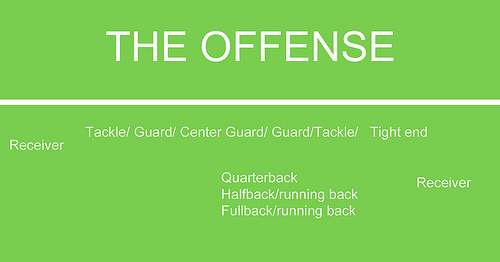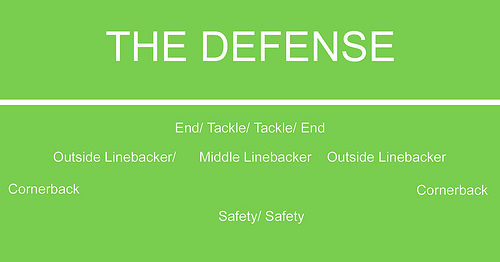My Corner Online
Football Guide for Women
FOOTBALL 101
Written 1/30/2011
National Football League (NFL) consists of two conferences: The American Football Conference (AFC) and the National Football Conference (NFC). The season winner from the AFC and the season winner from the NFC play at the Super Bowl.
The offense team tries to get the ball too the end zone. The defense team tries to stop them.
The offense team is given four plays (attempts) to go 10 yards. Once the team takes the ball 10 yards, they are given four more plays to go an additional 10 yards. The attempts are called "downs." (ie. 2nd and 4, meaning 2nd attempt and 4 more yards to go)
The line where the ball was last "downed" (where the player was last knocked down with the ball) is called the "line of scrimmage" and the two teams face each other at this line.
There are two men standing on the side of the field with poles, one pole is line of scrimmage and the other pole is where the team must reach. With new technology, you will now see digital lines across the field while watching on the television to help visualize where the team must reach.
If a team goes backwards during its four attempts, the number of yards to reach will be more than 10. (ie. 2nd and 14, meaning 2nd attempt and 14 more yards to go)
If they do not make the 10 yards in their 4 attempts, the other team becomes the offense and the game goes in the opposite direction towards the other end zone.
Therefore, when you hear the announcer say "first and ten" that is a good thing because the offensive team keeps the ball and is given four more tries.
A touchdown is 6 points. The team kicks the ball through the "uprights" and over the "crossbar" (goalpost) for an extra point.
On a 4th down, a team has the option to kick a field goal from wherever the ball is at on the field, rather than running or throwing the ball. This is worth 3 points.
On a 4th down, a team has the option to punt (kick) the ball trying to get it as far down field as possible. When the ball changes direction, this means the new offensive team has further to go to make a touchdown. If a punt goes through the uprights or into the end zone, it is called a "touchback" and the new offensive team starts with the scrimmage line on the 20 yard line.
What is the difference between a punt and a field goal kick? In field goal kick, the ball is placed on the the ground first (video) (or on a T - (video). In a punt, the ball is dropped from the hands (video).
A team has an option after the touchdown to make a play close to the goal line to get the ball over the line, rather than kicking the ball. If they succeed, they receive 2 extra points, rather than 1. This is called a "two point conversion."
An "interception" is when the defense catches a ball intended for the offense to catch. The defensive team then becomes the offensive team and the direction of the ball changes towards the opposite end zone.
A defensive team can score in two ways. First, if the defensive team intercepts the ball and gets the ball to their endzone during the same play. Second, if the offensive team is pushed into their own endzone and a defensive tackles the player with the ball within that endzone, then the defensive team scores 2 points. This is called a "safety."
Fumbling the ball in your own endzone, the balling going across the sideline in your own endzone, or any other type of ball loss in your own endzone is also considered a safety score.
Here's a good video that I could not embed.
THE POSITIONS
OFFENSE
Guard, Tackle, Tight End, Wide Receiver
Backs: Quarterback, Fullback, and Halfback/Running Back

The center guard (known as "the center") snaps the ball to the quarterback and puts it into action. The center is often the team captain.
The quarterback either hands the ball to a running back or throws the ball to a receiver.
The receiver runs around trying to "get open" for the quarterback to throw the ball to him.
If 2 tight ends are used, they are on either side of the tackles. If an end moves away from a tackle, they are called a "split end."
There are 11 players on the field and the positions can vary depending on the "formation" for example:
One running back, two tight ends, and two wide receivers
Two running backs, one tight end, and two wide receivers
One running back, one tight end, and three wide receivers
One running back, no tight end, and four wide receivers
No running backs, no tight end, and five wide receivers
These formations are what we see when television shows have a scene where the coach sets up the intended plays for the team.
OTHER OFFENSIVE PLAYERS
The "kicker" is the one who kicks the field goal.
The "holder" is the one who receives the snap before a field goal and holds the ball for the kicker.
When a team initially becomes the offensive team after a touchdown, the ball is kicked (kickoff) and the "kick returner" catches the ball and runs until taken down (sacked). The place where the kick returner is sacked is where the 1st and 10 scrimmage line begins.
DEFENSE
Tackle, End, Linebacker, Cornerback, Safety
The tackles and ends are in the front and called "defensive linemen."
The linebackers are on the next row.
The cornerbacks and safeties are in the back and are called "defensive backs."

The middle tackle is sometimes called the "nose guard" and gets in position across from the center guard who snaps the ball at the beginning of the play.
It is often the cornerbacks who intercept a pass being made between the offensive quarterback and receiver. This is called an "interception" and the defensive team becomes the offensive team.
A "blitz" is when a linebacker tackles the quarterback.
There are 11 players on the field and the positions can vary depending on the "formation" for example:
Five linemen, two linebackers, and four backs (the 5-2 formation)
Five linemen, three linebackers, and three backs (the 5-3 formation)
Four linemen, three linebackers, and four backs (the 4-3 formation)
Four linemen, four linebackers, and three backs (the 4-4 formation)
Three linemen, four linebackers, and four backs (the 3-4 formation)
Three linemen, three linebackers, and five backs (the 3-3-5 formation)
Four linemen, two linebackers, and five backs (the Nickelback formation)
Four linemen, one linebacker, and six backs.(the Dimeback formation)
Three linemen, one linebacker, and seven backs (the Quarter formation)
Three linemen, no linebackers, and eight backs (the Half Dollar formation)
OTHER DEFENSIVE PLAYERS
The "punter" kicks the ball to the other team during a "kick off" for the offensive "kick receiver" to catch.
PENALTIES
There are many penalties in football and it can be confusing to someone new to football.
Of course, there are obvious penalties for unsportsmanship conduct.
Here are some other common penalties:
Interference is probably the most commonly heard and occurs when a defensive player interferes with the receiver catching the ball. The receiver must be allowed to catch the ball before they are tackled. An interference also occurs when an offensive player either interferes with a defensive player trying to catch an interception.
Personal foul is when a player hits another player in a harmful way.
Holding is when a player holds another player who does not have the ball so they cannot get away.
Face mask is when a face mask on a helmet is grabbed.
Off sides is when the defense moves forward before the offense puts the ball into play.
Fall start is when the offense moves forward before they put the ball into play.
Come to the forum and chat with us and share what else you know!